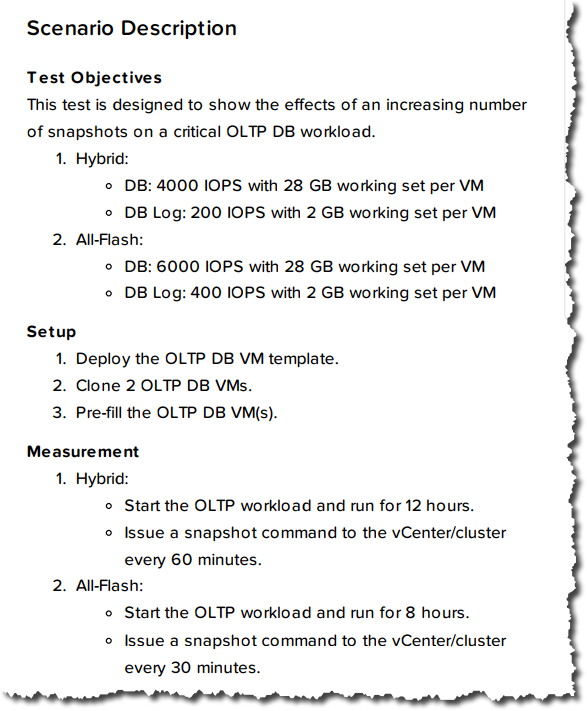In the first part of this series, I introduced Nutanix X-Ray benchmarking tool which has been designed very differently to traditional benchmarking tools as the performance of the app is the control and the variable is the platform,not the other way around.
This is done by generating realistic IO patterns (e.g.: Not 100% 4k read) and then performing functions against the platform to see how the control (the VM application performance) is impacted by the underlying platforms functionality.
A great example of this is performing snapshots as the first step in a space efficient backup solution.
X-Ray has a built in test which generates an OLTP workload which is ran for 8 hours which for an all flash platform generates 6000 IOPS across the database and 400 IOPS for the logs. The scenario is detailed in the X-Ray report shown below.
The Snapshot impact scenario is then ran against multiple platforms and using the Analysis functionality within X-ray. we can generate a report which overlays the results from multiple platforms.
The below example is GA Acropolis Hypervisor (AHV) on AOS 5.1.1 verses a leading hypervisor and SDS platform showing the snapshot impact scenario.
Each of the red lines indicate a snapshot and what we observe is the performance of both platforms remains consistent until the 10th snapshot (shown below) where the Nutanix platform continues without impact and the leading hypervisor and SDS platform starts degrading significantly.
In the real world, customers use the intelligent features of storage, SDS or hyper-converged platforms but rarely test how this functionality works prior to purchasing. This is because it’s difficult and time consuming to do so.
Nutanix X-Ray tool makes the process of validating a platforms performance under real world scenarios a quick and easy process and provides automatically generated reports where accurate comparisons can be made.
What this example shows is that while both platforms could achieve the required performance without snapshots, only Nutanix AHV & AOS could maintain the performance while utilising snapshots to achieve the type of recovery point objective (RPO) that is expected in production environments, especially with business critical workloads.
As part of the Nutanix Solutions and Performance engineering organisation, I can tell you that the focus for Nutanix is real world performance, using data reduction, leveraging snapshots, mixing workloads and testing a large scale.
In upcoming posts I will show more examples of X-Ray test scenarios as well as comparisons between GA Acropolis Hypervisor (AHV) & AOS 5.1.1 verses a leading hypervisor and SDS platform.
Related Articles:
Nutanix X-Ray Benchmarking tool Part 1 – Introduction
Nutanix X-Ray Benchmarking tool Part 3 – Extended Node Failure Scenario




You must log in to post a comment.